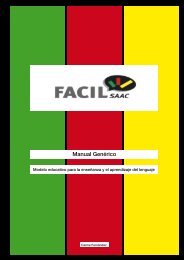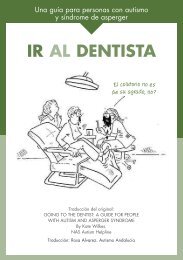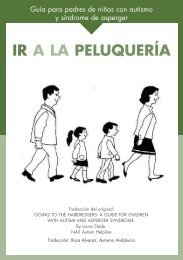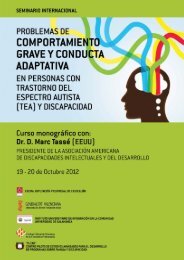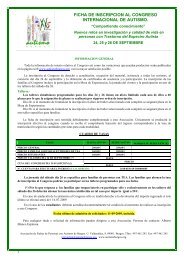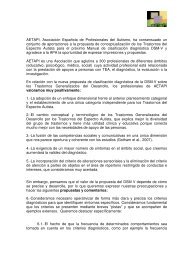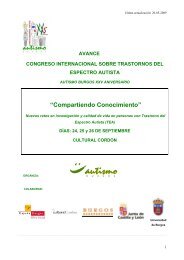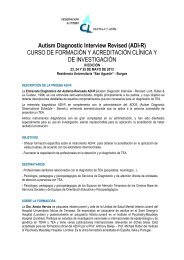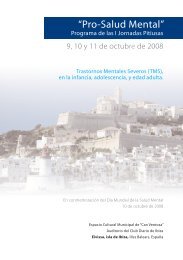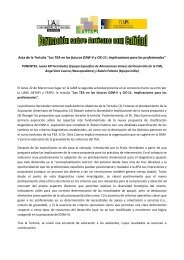persons with autism spectrum disorders - Aetapi
persons with autism spectrum disorders - Aetapi
persons with autism spectrum disorders - Aetapi
Create successful ePaper yourself
Turn your PDF publications into a flip-book with our unique Google optimized e-Paper software.
Persons <strong>with</strong> Autism Spectrum Disorders<br />
In summary, there are deficits in all the behaviours required to<br />
engage in and regulate reciprocal social interaction. There are often<br />
marked difficulties in identifying, understanding and sharing others’<br />
emotions; the individual’s own repertoire of expression and regulation<br />
of emotions is also affected.<br />
Restricted Repertoire of Interest and Behaviours<br />
Imaginative skills are almost always impaired to some degree. As<br />
children, most individuals fail to develop normal pretend play and<br />
this, in turn, limits their capacity to understand and represent intentions<br />
and emotions in others. In some cases imaginative activity may<br />
be present, indeed even excessive, but this does not lead to improved<br />
functional adaptation or participation in social play <strong>with</strong> peers. The<br />
failure to develop an inner representation of others’ minds also affects<br />
the capacity both for anticipating what may happen in the future and<br />
for coping <strong>with</strong> past events.<br />
Behavioural patterns are often repetitive and ritualised. These may<br />
include attachments to unusual and bizarre objects. Stereotyped,<br />
repetitive movements are also common.<br />
There is often a strong resistance to change and insistence on<br />
sameness. Even minor changes in the environment can cause<br />
profound distress. Many children <strong>with</strong> <strong>autism</strong>, particularly those <strong>with</strong><br />
higher intellectual ability, develop specific interests or preoccupations<br />
<strong>with</strong> unusual topics.<br />
OTHER IMPORTANT ASPECTS TO BE TAKEN INTO<br />
CONSIDERATION<br />
Many individuals show hyper- or hypo-sensitivities to tactile, auditory,<br />
and visual stimuli; there may also be unusual responses to heat and<br />
cold and/or pain.<br />
Other commonly associated, non-specific features include high levels<br />
of anxiety, sleep problems, abnormal feeding patterns, sometimes<br />
resulting in gastrointestinal disturbances (although these appear to<br />
be associated more <strong>with</strong> developmental delay than to <strong>autism</strong> per se),<br />
severe tantrums and self-injurious behaviour.<br />
Many individuals <strong>with</strong> ASD are affected by other behavioural and<br />
psychiatric problems. These are referred to as “Co-morbidities” and<br />
<br />
<strong>with</strong> <strong>autism</strong> are often limited.<br />
Their capacity for pretend<br />
play and social play does<br />
not develop well. As a result,<br />
they have difficulties in<br />
understanding or adapting to<br />
the intentions and emotions of<br />
others, managing past events<br />
or anticipating the future.<br />
Behaviour is often stereotypical,<br />
repetitive and ritualised.<br />
Most children <strong>with</strong> <strong>autism</strong><br />
demonstrate strong resistance<br />
to change and insistence on<br />
routine. Their interests are often<br />
specific or unusual.<br />
Many <strong>persons</strong> <strong>with</strong> <strong>autism</strong> over-<br />
or under-react to tactile, auditory<br />
and visual stimuli. They may also<br />
have unusual responses to heat,<br />
cold and/or pain.<br />
Persons <strong>with</strong> <strong>autism</strong> may also<br />
have other problems such<br />
as: anxiety, sleep problems,<br />
abnormal feeding patterns,<br />
severe tantrums and selfinjurious<br />
behaviour.<br />
Many <strong>persons</strong> <strong>with</strong> <strong>autism</strong><br />
also have other behavioural<br />
and psychiatric problems or<br />
associated <strong>disorders</strong>. These are<br />
called “Co-morbidities”.<br />
“Co-morbidities” must be given<br />
proper consideration.<br />
Assessment may indicate that<br />
the environment or treatment<br />
plan is unsuitable and should<br />
be changed. In other cases, the<br />
5




